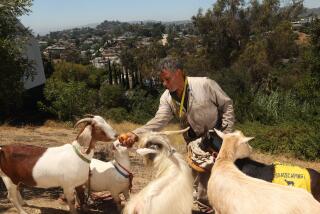125 Wild Goats Netted in Rescue Operation
- Share via
A total of 125 wild goats targeted for destruction on San Clemente Island have been netted and corraled without injury after the third day of a difficult aerial and ground rescue operation by animal rights activists.
“I’m ecstactic,” said Cleveland Amory, noted author and head of the international Fund for Animals, which has led the fight against the U.S. Navy’s plan to slaughter the goats.
“Not in my wildest dreams did I expect 125 goats in the first three days,” Amory said. “I thought the goats would scatter into the ravines and canyons . . . . And we’ve had no injuries (to goats) at all, which is incredible with this kind of capture technique.”
Amory said widespread publicity of the rescue effort has resulted in “hundreds of calls” to the fund’s Los Angeles office from people offering to adopt the goats.
One month ago, helicopter-borne naval sharpshooters were to begin an aerial assault on the island’s estimated 1,500 feral goats because the voracious and prolific animals allegedly are a threat to the habitat of several endangered species protected by the U.S. Environmental Protection Act of 1973.
But U.S. Secretary of Defense Caspar Weinberger intervened on Jan. 3, less than 24 hours before the shooting was to begin. After pleas from Amory and Rep. Bobbi Fiedler (R-Northridge), the secretary overruled top Navy officials and gave animal protectionists until Feb. 28 to trap and remove as many goats as possible.
Amory said only half the goat population can be rescued in the current trapping operation because the remaining 700 to 750 are in an area saturated with unexploded shells. The island, located about 60 miles offshore from north San Diego County, is owned by the Navy and is used for bombing and shelling practice.
Since the early 1970s, San Clemente Island’s feral goats have been shot and trapped in Navy efforts to eradicate them. Animal protectionists conducted two previous trapping operations but have been unable to keep up with the goats, which are able to reproduce their numbers rapidly.
Navy biologists now say the animals--believed to be descendants of domestic goats brought there by seamen as long as 200 years ago to provide food for passing sailors--are destroying the habitats of several plants, two species of lizard and one bird unique to the island and on the federal list of endangered species.
“I feel they just sort of discovered the endangered species laws,” said Amory from his hotel suite in Beverly Hills. “It’s nonsense on an island they shell 49 weeks out of 52. They’re certainly not worried about shells hitting the lizards.”
Friday, the roundup began in earnest with helicopter pilot Mel Cain of El Cajon swooping in low so that Bill Hales of New Zealand could fire a netting device that entangles the animal for crews to capture.
Developed by Hales, a member of the Fund for Animals, the net is packed in a metal casing attached to a sawed-off shotgun.
A record 60 goats were captured and corraled the first day. By late Sunday, 125 of the hardy creatures were munching hay in a secluded corral on the island, awaiting transport by barge to holding areas
Considering that the goats are being chased over rocky terrain when the nets descend upon them, Amory said it was remarkable that only one animal so much as scraped a leg.
He said the success of the first three days suggests they may well reach their goal of removing 750 to 800 of the animals for adoption by Weinberger’s deadline.
Previously, more than 1,200 of the feral goats were caught and removed from the island in rescue operations in 1983 and the summer of 1984. Those animals were taken to the Fund for Animals ranch in Texas then offered up for adoption.
On Thursday, barges will transport goats captured during the first week of rescue efforts to the mainland. Amory said 50 will go to the Animal Trust sanctuary in Ramona, in San Diego County, and another 50 to a smaller holding facility nearby. Others will go to a ranch in Chino and to the Los Angeles County animal shelter in Castaic.
Amory predicted that all the animals will be adopted by Southern Californians. He said more than 120 people in the Chino area alone want to be goat owners.
“The calls are coming in so fast, we can’t honestly tell you how many people want to adopt them,” he said.
There will be a charge of $25 for the billy goats and $35 for the nannys. But Amory said, “We’re likely to give them a special break if they adopt two.”
Although born in the wild, he said the once-domesticated species of goats “will revert back very quickly and will make wonderful pets.”
To arrange a goat adoption, call 818-789-1190.
More to Read
Sign up for Essential California
The most important California stories and recommendations in your inbox every morning.
You may occasionally receive promotional content from the Los Angeles Times.













